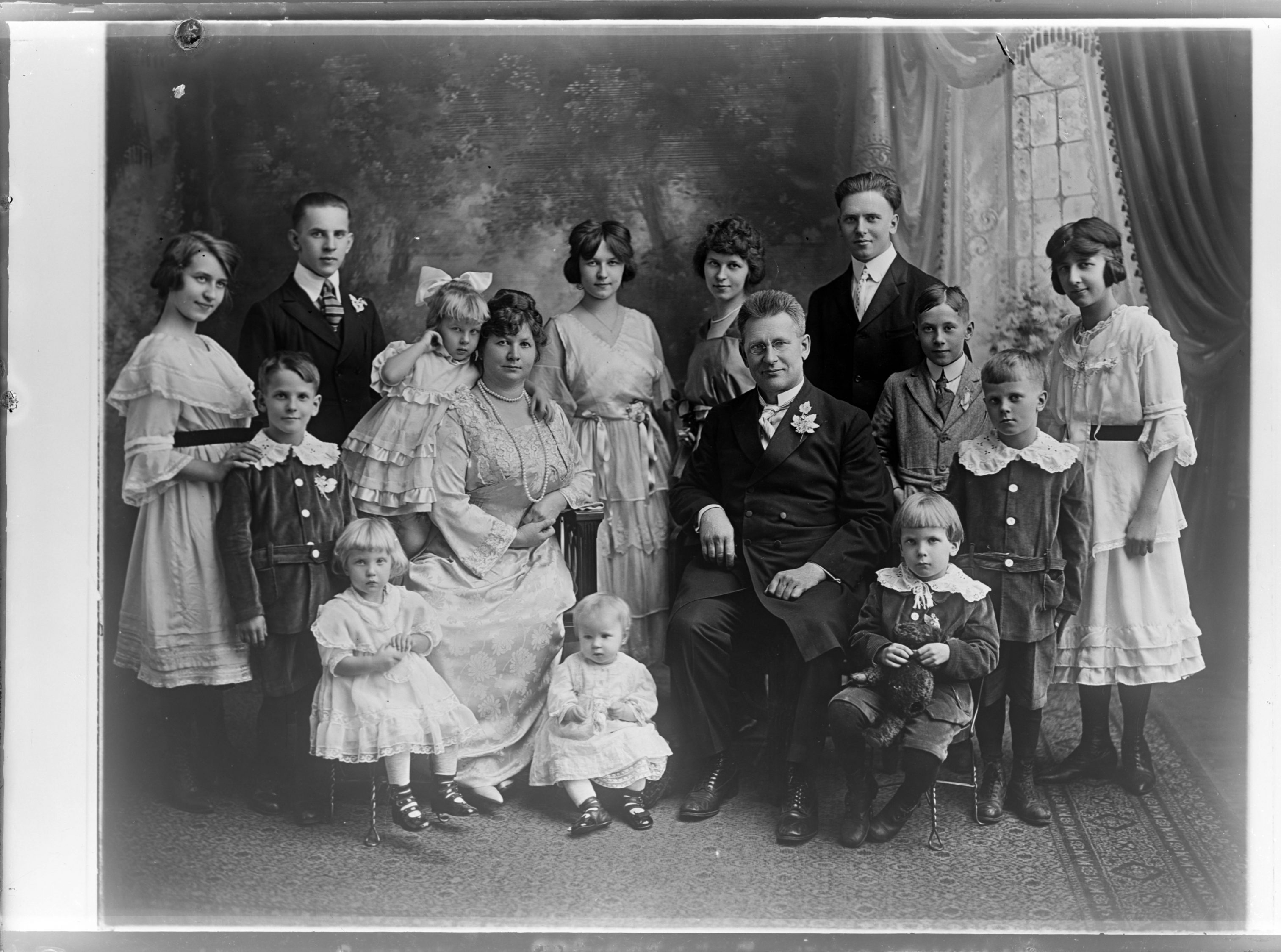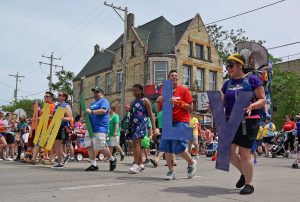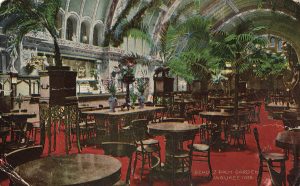The “family” is a core institution of all known human societies. There are a variety of definitions, reflecting the complexity of the concept. At its simplest, the family is “a group of persons united by the ties of marriage, blood, or adoption,” who usually, but not necessarily, live together in a “household.”[1] More expansive definitions include other relatives living elsewhere, one’s lineage, or other social groups, as in usages such a “family reunion” or the “family of man.” In the context of Milwaukee’s experience, both the narrower and the more expansive notions are relevant and encompass economic, demographic, spatial, cultural, and political elements that have shaped people’s lives in the area over the centuries.[2]
Individual families have histories, punctuated by the life events, births, deaths, and marriages of their members. Over the life course, an individual most commonly is born into a birth family, grows to maturity, forms a marital relationship, and in turn produces children for the next generation. There are many exceptions to this simple schema which affect the character of an individual family at any point in time. Parents may die, leaving a child an orphan. Individuals can abandon their families, through migration or divorce. Wars, natural disasters, and economic crises disrupt family life. For the Milwaukee region, the history of the family is a story of both continuity and disruption, as the physical space was populated and repopulated by successive peoples and economic systems.
From Native to Euro-American Society
Native, or American Indian, hunter-gatherer communities inhabited the Great Lakes region for millennia. In the period before European contact, the Milwaukee area had small seasonal villages of tribal communities that gathered wild fruits and nuts, cultivated corn, beans, and squash, harvested wild rice, and fished and hunted. For the Potawatomi, for example, individual families belonged to clans, which undertook collective economic activities. Descent was patrilineal and marriages were exogamous, which meant that a person had to marry someone from a different clan. These patterns facilitated ongoing relationships among the clans, moral guidelines for mutual respect among family members and kin. The patterns, in the absence of formal permanent leadership or governmental structures, provided the social glue for the good of the overall community.[3]
When European explorers encountered the Great Lakes Indian communities in the seventeenth and eighteenth centuries, they brought with them very different patterns. The Europeans belonged to state-based societies, had imperialist economic goals and their own ideas about the ideal type of family organization and social relationships. In a nutshell, the New World was a space to be exploited and sometimes settled, and the peoples living there were to be integrated into an emerging Atlantic world economy, initially as trading partners or conquered labor, and ultimately removed in favor of people of European descent.
For the Great Lakes region, the French initially were the dominant imperial power, and the fur trade served as the main economic engine. Unlike the settled plantation-based economies created in the Caribbean and southern British colonies, or the Protestant dissenter religious communities of New England, the fur trading economy in the Wisconsin region, particularly in the eighteenth century, did not involve major migrations of Europeans into the region. Small numbers of French voyageurs, men, travelled to local Indian communities to develop robust trading relationships for beaver pelts in exchange for cloth, guns, and metal ware. The French trader might “marry” into a native community, and the children of this new family, over time, led to the “Métis” communities of mixed French and Indian heritage.
The British and French battled for control of North America in the 18th century, and when the British defeated the French in the French and Indian Wars in 1763, the Great Lakes region became part of the British Empire. The British lost the region to the Americans in the Revolutionary War. Though the Milwaukee region was nominally part of the United States Northwest Territory after 1787, in fact the fur trading economy did not change immediately, and the American Indian societies remained relatively unchanged.
By the early nineteenth century, however, Indian wars and family farm settlement of eastern and southern portions of the Northwest Territory, i.e., Ohio, Indiana and Illinois, pushed Indians out of the area and signaled that the Indian world of networks of small, semi-migratory, clan-based, seasonal villages was about to end. Wisconsin Indians ceded control of land to the U.S. federal government by the early 1830s, and a land boom followed. The new settlements were based on freehold farms and urban, permanently platted street lots, designed to house the nuclear families and individual migrants from the East and Europe.
The families who inhabited the Milwaukee region from the mid-nineteenth century on were based upon and had to accommodate to Euro-American economic, cultural and legal conceptions of the proper family situation, notably the patriarchal nuclear family model, with a male household head who “governed” his household, voted and participated in public life on its behalf, and controlled the property of his wife and children.[4] Lived reality on the ground was always more complex, particularly since Wisconsin was founded during and took sustenance from the radical democratic movements for women’s rights, antislavery, and labor reform of the day, but the law, and the conventions for house building, neighborhood design, and local farms, literally built into the infrastructure of the region the possibilities for family life.
Population Growth and Family Change
From 1850 through the beginning of the twenty first century, the four county Milwaukee metropolitan region exploded in population. The city’s population was 20,000 in 1850, peaked at 741,000 in 1960, and then declined to just under 600,000 in 2010. Milwaukee, Ozaukee, Washington, and Waukesha counties grew from 70,000 people in 1850 to 1.6 million in 2010. The overall story is one of growth, but it is also a story of living arrangements, of families and households settling the land and building the economy, housing, and infrastructure for themselves and their posterity.[5]
From the mid-nineteenth century to the second half of the twentieth century, most people in the Milwaukee are lived in families headed by a married couple. In 1900, for example, 84 percent of people in the Milwaukee metro area lived in families headed by a married couple. That dropped to 63 percent in 1990 and 56 percent by 2010 as new household and family relationships emerged. Notably, in Milwaukee and nationally, single person households, i.e., non-family households, proliferated as more people lived alone. In 2010, 37 percent of Milwaukee area households were “single person households” and 15 percent of Milwaukeeans lived in “non-family households”—i.e., people living along or in households without other family members. Relatedly, household and family size also dropped over the course of the past century and a half. In 1850, the average dwelling housed 5.6 people; the average family size was 4.8 people. By 1930, average family size dropped to 3.8; it was 2.3 in 2017. In 1880, 47 percent of Milwaukee area household heads lived in households with at least three of their own children. That dropped to 19 percent in 1970 and stands at 8 percent in 2017. As of 2017, 65 percent of Milwaukee area household heads did not have any of their own children living in the household.
Organization of Space
These basic demographic patterns framed how Milwaukeeans organized their living spaces, shaped area and neighborhood housing patterns, and conceived of how to build houses (i.e., size and layout) for this dynamic family environment. The physical infrastructure earlier generations of Milwaukeeans built both served and constrained the possibilities of the family life of later generations. A majority of people in Ozaukee, Washington, and Waukesha counties lived on farms in the nineteenth century. A third still did in 1940. Milwaukee County was characterized by urban housing patterns and the separation of home life and work life from its mid-nineteenth century founding. After 1940, Milwaukee County and the suburban counties were both characterized by the physical separation of work and family life.
Nineteenth century housing development in both the city and the larger metropolitan area was driven by economic growth patterns. In the expanding walking city of the nineteenth century, physical location of businesses and factories was shaped by the need for people to get to work, and the strong preference of Milwaukee’s immigrant communities, particularly the Germans and Poles, to own their homes. As the city grew into a manufacturing powerhouse, larger industrial complexes stood cheek by jowl with densely populated workers’ cottages and duplexes, and families endured the noise, smells, and hubbub of nearby factories.
By the early twentieth center, the city of Milwaukee was a very congested place, with population densities second only to New York City, at 18,000 people per square mile. One of the major goals of Milwaukee’s early twentieth century socialist city planners was dispersion of that congestion, through annexation of land outside the existing city limits and by zoning regulations that favored single family home construction, minimum lot size requirements, and prevention of secondary living dwellings on residential lots. Land use districts were designed for “residential, local business, commercial and light manufacturing, and industrial” areas, separating residential areas and thus family life from places were people worked. Transit networks, and later automobile transportation allowed the city to expand and the larger metropolitan area to urbanize. The city of Milwaukee quadrupled in land area in the next half century, accommodating residential population growth in mostly low-rise housing. Suburbs sprouted in Milwaukee County, and the outlying metropolitan counties were also characterized by the separation of home and work life and encouraged generous house lots for single-family homes. In the areas annexed to the city from the 1920s to the late 1960s, land use patterns looked quite like those developing in the suburbs.[6]
Industrial to Post-Industrial Milwaukee
In the heyday of Milwaukee’s industrial economy of the first half of the twentieth century, the “ideal” family had a male breadwinner, homemaker wife, and comfortable home for raising children. The labor movement which turned Milwaukee into a union town during this period negotiated for a husband’s “family wage,” an income and benefit package sufficient to support the entire family. Larger American social policies supported the male breadwinner family model as well. Local public schools, compulsory school attendance laws, and the regulation of child labor at the state and national level were designed to keep children out of the labor force until their mid-teenage years at minimum. Wisconsin pioneered the progressive reform of working conditions, including workmen’s compensation and unemployment insurance, that buttressed workingmen’s capacity to support their families.[7] By the 1930s, the national Social Security Act initiated a set of guarantees to provide “security” to American families, most notably an old age pension and disability benefits to American workers. The Social Security Act also made unemployment insurance a national program. And, Title IV, also known as Aid to Families with Dependent Children or “Mother’s pensions,” was designed to keep a woman at home caring for her children if her husband died or abandoned the family.[8]
In 1970, four out of five people in the Milwaukee metro area still lived in a family household headed by a married couple. But change was on the horizon. The baby boom, which had fueled local growth after World War II, stopped in the 1960s. Milwaukee’s manufacturing economy faltered from the 1970s on, and plant closings led to the erosion of working-class men’s ability to support a family on their own. Wives in married couple families increasingly worked in the paid labor force. Locally and nationally, dual earners in married couple families became the norm. In 1950, 23 percent of wives aged 15-65 in married couple families in the Milwaukee area reported being in the paid labor force. By 1990, 70 percent did. Social Security pensions and longer life expectancy made for substantial growth in the over 65 population, living independently or alone. Second-wave feminism and the sexual revolution encouraged women and LGBT people to see the possibilities for adult living arrangements outside a heterosexual marriage. Young people increasingly pursued higher education and unmarried independent living into their twenties. Gay marriage is legal. The male breadwinner, female homemaker, minor children family model no longer dominated the Milwaukee landscape.
The twenty first century Milwaukee area family is in transition, without a dominant model. A variety of family and household arrangements characterize the metropolitan region. A majority (55 percent) of people in the metro area still lived in married couple households in 2017. However, in the city of Milwaukee, this figure was only 38 percent. Family patterns in Milwaukee’s ethnic communities also display differences. In the city, 42 percent of the black population lived in families headed by a female householder. Fifty nine percent of the Mexican population in the city lived in married couple families.
The Culture of Family in Milwaukee
Entertainment, dining, and sporting institutions accommodated family patterns and interacted with the daily life of families. As Elizabeth Jozwiak chronicled, for example, “German immigrants brought their tradition of beer drinking in saloons and beer gardens with them to Milwaukee” and built taverns “suitable for the family, known as ‘Bierhallen mit familieneingang’ or saloons with family entrance.” They offered musical entertainment for the families on Sunday afternoons, the only time the entire family could go out together in the days when the workweek included Saturday.[9] The Milwaukee County Park system was built to provide easy access to open spaces for sports and picnics for the urban population. Particular sports such as baseball ran the gamut from Little League teams where parents coached their children, to the Major League Braves and Brewers, where families anchored the fan base for the team. Diverse 21st century family living arrangements have not reduced the importance of family relationships in the lives of the people of Milwaukee. The city’s convention and visitor’s bureau, “Visit Milwaukee,” boasts that “The City that Beer Built” is also a “Family Friendly” destination, and the family pages list family friendly events, locations for family reunions, and a guide for the best local “family vacation.”[10]
Footnotes [+]
- ^ “Family,” Encyclopedia Britannica, last accessed October 5, 2019
- ^ The term “economics” derives from the Greek word “oikos” meaning family or household. For most of human history, the “family” was also the primary economic unit of a society.
- ^ “Indian Country, Potawatomi Culture,” Milwaukee Public Museum, accessed July 11, 2019.
- ^ See Catherine B. Cleary, “Married Women’s Property Rights in Wisconsin, 1846-1872,” The Wisconsin Magazine of History, 78, no. 2 (Winter, 1994-1995): 110-137. Cleary opens the article with the classic quote from Blackstone on the English common law: “By marriage, the husband and wife are one person in law; that is, the very existence of the woman is suspended during marriage, or at least is incorporated and consolidated into that of the husband.” Cleary added, “The law gave the husband control of his wife’s personal property, tangible and intangible (including her earnings), and gave him the right to manage her real estate and receive the rents and profits for the duration of the marriage or, if a living child was born of the marriage, for his life.”
- ^ All tabulations of U.S. decennial census data calculated from the IPUMS census databases, Steven Ruggles, Sarah Flood, Ronald Goeken, Josiah Grover, Erin Meyer, Jose Pacas and Matthew Sobek. IPUMS USA: Version 9.0 [dataset]. Minneapolis, MN: IPUMS, 2019. https://doi.org/10.18128/D010.V9.0.
- ^ John McCarthy, “Dreaming of a Decentralized Metropolis: City Planning in Socialist Milwaukee,” Michigan Historical Review 32, no. 1 (Spring 2006), 33-57; Todd J. Fulda, “Daniel Hoan and the Golden Age of Socialist Government in Milwaukee,” American Journal of Economics and Sociology 75, no. 1 (January 2016), 246-260.
- ^ “The Early Labor Movement in Wisconsin,” Wisconsin Historical Society, accessed September 2, 2019.
- ^ Historical Background and Development of Social Security, U.S. Social Security Administration, accessed September 1, 2019; U.S. Social Security Administration, Reports and Studies, Committee on Economic Security (CES), “Social Security in America,” Part III, Security for Children, Chapter XIII, Aid to Dependent Children, accessed September 1, 2019.
- ^ Elizabeth Jozwiak, “Bottoms Up: The Socialist Fight for the Workingman’s Saloon,” The Wisconsin Magazine of History 90, no. 2 (Winter 2006-2007), 12-23, quote at 13.
- ^ VISIT Milwaukee, https://www.visitmilwaukee.org/about-us/ and https://www.visitmilwaukee.org/plan-a-visit/guides/family-friendly/, last accessed October 14, 2019.
For Further Reading
Cherlin, Andrew. Labor’s Love Lost: The Rise and Fall of the Working-Class Family in America. New York: Russell Sage, 2014.
Coontz, Stephanie. The Way We Never Were: American Families and the Nostalgia Trap. New York: Basic, 1992.
Ruggles, Steven. “Patriarchy, Power, and Pay: The Transformation of American Families, 1800-2015.” Demography 52 (2015): 1797-1823.




0 Comments
Please keep your community civil. All comments must follow the Encyclopedia of Milwaukee Community rules and terms of use, and will be moderated prior to posting. Encyclopedia of Milwaukee reserves the right to use the comments we receive, in whole or in part, and to use the commenter's name and location, in any medium. See also the Copyright, Privacy, and Terms & Conditions.
Have a suggestion for a new topic? Please use the Site Contact Form.